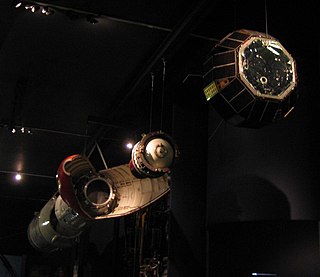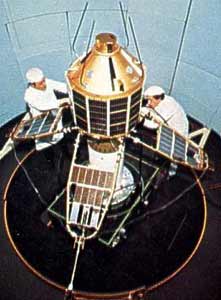
The de Havilland Propellers Blue Streak was a British Intermediate-range ballistic missile (IRBM), and later the first stage of the Europa satellite launch vehicle. Blue Streak was cancelled without entering full production.

Black Arrow, officially capitalised BLACK ARROW, was a British satellite expendable launch system.
ORBCOMM is an American company that offers industrial internet and machine to machine (M2M) communications hardware, software and services designed to track, monitor, and control fixed and mobile assets in markets including transportation, heavy equipment, maritime, oil and gas, utilities and government. The company provides hardware devices, modems, web applications, and data services delivered over multiple satellite and cellular networks.
The British National Committee for Space Research (BNCSR) was a Royal Society committee formed in December 1958. It was formed primarily to be Britain's interface with the newly formed Committee on Space Research (COSPAR).
The British space programme is the British government's work to develop British space capabilities. The objectives of the current civil programme are to "win sustainable economic growth, secure new scientific knowledge and provide benefits to all citizens."

Skynet 5B is a military communications satellite operated by Astrium Services, formerly Paradigm Secure Communications, on behalf of the British Ministry of Defence. It was the second of four Skynet 5 satellites to be launched.

Ariel 3 was a satellite in the Ariel programme, a satellite partnership between the US and UK. Three of the onboard experiments continued research from the first two missions and two experiments were designed for new research topics. It was launched from Vandenberg Air Force Base on 5 May 1967, making it the first satellite of the program to launch from the West coast. Ariel 3 was shut down in September 1969, and re-entered the Earth's atmosphere 14 December 1970.

Waxwing was a British solid rocket motor used for apogee kick as the 3rd (upper) stage of the Black Arrow satellite launch vehicles. It was also known as Black Arrow-3. Waxwing was used to successfully place the Prospero X-3 satellite into low Earth orbit on 28 October 1971, Britain's only satellite launched on an indigenously developed launch vehicle. Before being separated from the Black Arrow launch vehicle, it would be spun on a turntable using six radial 'Imp' solid rocket motors to spin stabilise the satellite. This means that any discrepancy in thrust in any direction would be cancelled out. The Waxwing motor is now out of production.
Launch Area 5 (LA5) is an operational site at the RAAF Woomera Test Range which forms the primary operational capability of the Woomera Range Complex. Originally LA5 was a rocket launch site which supported a number of British experimental launches, including the United Kingdom's first, and as of 2023 only, satellite launch. It consisted of three separate launch pads, which supported 22 Black Knight sounding rocket launches, and four Black Arrow carrier rocket launches. Of the four Black Arrow launches, two were orbital launches, the first of which, on 2 September 1970, failed, and the second, on 28 October 1971, succeeded, placing the Prospero satellite into low Earth orbit.
Ariel was a British satellite research programme conducted between the early 1960s and 1980s. Six satellites were launched as part of the programme, starting with the first British satellite, Ariel 1, which was launched on 26 April 1962, and concluding with the launch of Ariel 6 on 2 June 1979. The launch of Ariel 1 made Britain the third country to have a satellite orbiting the Earth. The first four were devoted to studying the ionosphere, the remaining two to X-ray astronomy and cosmic-ray studies.
Orbcomm is a family of low Earth orbit communications satellites, operated by the United States satellite communications company Orbcomm. As of July 2014, 51 such satellites have orbited Earth, with 50 still continuing to do so.
Orba, also known as X-2, was intended to be the first satellite launched by a British rocket. It was launched at 00:34 GMT on 2 September 1970, atop a Black Arrow rocket from Launch Area 5B at Woomera, but failed to reach orbit after the second stage of the carrier rocket shut down 13 seconds early. Orba was built from spare parts due to funding restrictions, and was to have been used to measure upper atmosphere density by monitoring the decay of its orbit.

Ariel 1, was the first British-American satellite, and the first satellite in the Ariel programme. Its launch in 1962 made the United Kingdom the third country to operate a satellite, after the Soviet Union and the United States. It was constructed in the UK and the United States by NASA Goddard Space Flight Center and SERC, under an agreement reached as the result of political discussions in 1959 and 1960. The US Starfish Prime exoatmospheric nuclear test affected Ariel 1's operational capability.

Ariel 4, known pre-launch as UK 4, was a British ionospheric research satellite, which was operated by the Science and Engineering Research Council. It was launched 11 December 1971, aboard an American Scout rocket. Experiments were designed to meet one scientific objective, making it the first mission-oriented satellite for the UK. It was also the first satellite in the Ariel programme to contain an American experiment. Ariel 4 decayed from orbit on 12 December 1978
Black Prince was a proposed British-led satellite expendable launch system. It would have made heavy use of the preceding Blue Streak missile and the Black Knight test rocket development programmes, as well as some new elements, to produce a British-built launcher capable of deploying medium-sized payloads into orbit. Popularly known as the Black Prince due to its assigned rainbow code, in official documentation, the platform was referred to as the Blue Streak Satellite Launch Vehicle (BSSLV).
Miranda, also known as X-4, is a British satellite in low Earth orbit. The satellite was launched in March 1974 as an engineering test bed of technologies in orbit.
Space Technology Research Vehicle, or STRV, was a series of British microsatellites which operated in elliptical orbits around the Earth. The satellites were built by the Defence Research Agency at Farnborough, for the UK Ministry of Defence.

Falcon 9 flight 20 was a Falcon 9 space launch that occurred on 22 December 2015 at 01:29:00 UTC. It was the first time that the first stage of an orbital rocket made a successful return and vertical landing.

Explorer S-55 was an American satellite launched by NASA on 30 June 1961, as part of the Explorer program. Explorer S-55, was launched using a Scout X-1 launch vehicle from the Wallops Flight Facility (WFF). Its mission was to evaluate the launch vehicle, and investigate micrometeoroid impact and penetration. The mission failed because the third stage failed to ignite and the spacecraft did not achieve orbit.

Orbiting Vehicle 1-1, was the first satellite in the OV1 series of the United States Air Force's Orbiting Vehicle program. OV1-1 was an American Earth science research satellite designed to measure radiation, micrometeoroid density, and magnetic fields in orbit. Launched 21 January 1965, the mission resulted in failure when, after a successful launch of its Atlas booster, OV1-1's onboard Altair motor failed to fire.










